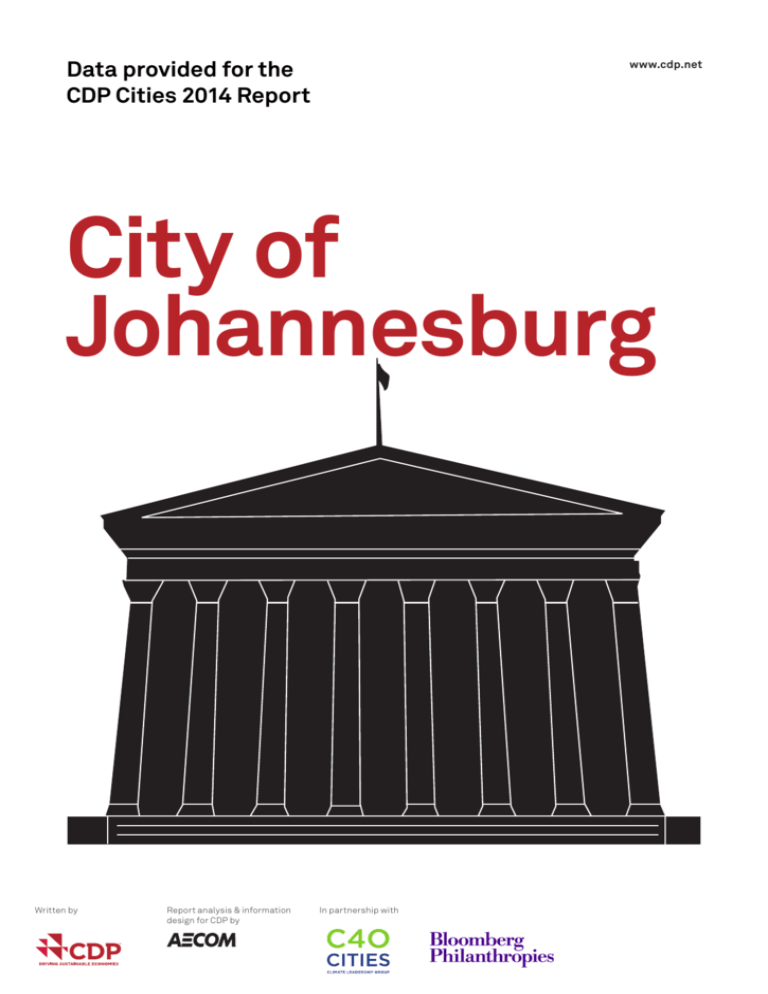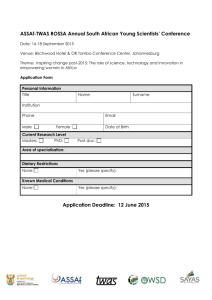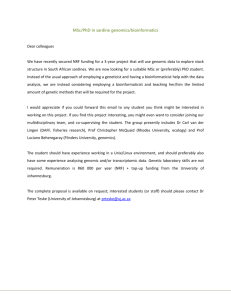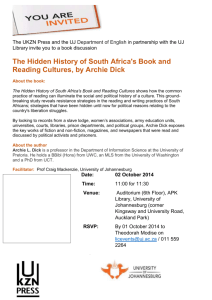Data provided for the CDP Cities 2014 Report
advertisement

Data provided for the CDP Cities 2014 Report www.cdp.net City of Johannesburg Written by Report analysis & information design for CDP by In partnership with Johannesburg in Context 04 Johannesburg in Focus 06 Introduction 08 Governance 12 Risks & Adaptation 16 Opportunities 26 Emissions – Community 28 Strategy 38 CDP, C40 and AECOM are proud to present results from our fourth consecutive year of climate change reporting for cities. It was an impressive year, with 207 cities reporting on their climate change data (an 88% increase from 2013), making this the largest and most comprehensive survey of cities and climate change published to date by CDP. City governments from Denver to Jakarta to Abidjan participated, including over 90% of the membership of the C40 – a group of the world’s largest cities dedicated to climate change leadership. Over half of reporting cities measure city-wide emissions. Together, these cities account for 1.2 billion tonnes CO2e, putting them on par with Japan, the world’s third largest economy and fourth largest emitter of greenhouse gas emissions. 60% of all reporting cities now have completed a climate change risk assessment. And cities reported over 2,000 individual actions designed to reduce emissions and adapt to a changing climate. CDP, C40 and AECOM salute the hard work and dedication of the world’s city governments in measuring and reporting these important pieces of data. With this report, we provide city governments the information and insights that we hope will assist their work in tackling climate change. This document contains the questionnaire data provided to CDP from the City of Johannesburg as part of its 2014 CDP submission. To see all of the results for all participating cities, visit https://www.cdp.net/ cities. The graphics in this document are from the 2014 CDP Cities infographic and Protecting Our Capital Report 4 CDP Cities 2014 Johannesburg Johannesburg in context 110 207 Number of cities responding per year 48 2011 73 2012 Johannesburg participation 2013 2014 5 Johannesburg in Context * Cities that reported privately Total population of cities responding in 2014 394,360,000 Johannesburg 4,400,000 people Where Johannesburg fits 91 small 59 medium 57 large >600k population 600k-1.6m population 1.6m+ population 6 CDP Cities 2014 Johannesburg Year reported 2014 Area (approximately) 155 km2 4,400,000 Population (approximately) Johannesburg in focus Inventory method Global Protocol for Community-Scale Greenhouse Gas Emissions (GPC) Pilot Version 1.0 (C40 and ICLEI) 7 Johannesburg in Focus 108 cities reporting emissions in 2014 50,000,000 80,000,000 metric tonnes CO2e metric tonnes CO2e 10 cities reporting emissions of greater than 30,000,000 metric tonnes CO2e Johannesburg 26,226,549 metric tonnes CO2e 8 cities reporting emissions of 20,000,000 to 30,000,000 metric tonnes CO2e 20,000,000 30,000,000 metric tonnes CO2e metric tonnes CO2e 10,000,000 19 cities reporting emissions of 10,000,000 to 20,000,000 metric tonnes CO2e metric tonnes CO2e 70 cities reporting emissions of less than 10,000,000 metric tonnes CO2e 5,000,000 metric tonnes CO2e 8 0 Introduction CDP Cities 2014 Johannesburg The City of Johannesburg (CoJ) Metropolitan Municipality is located in Gauteng, the wealthiest province in South Africa, having the largest economy of any metropolitan region in Sub-Saharan Africa. Johannesburg, also known as Jozi, Joburg or eGoli, is the largest city in South Africa. The City is one of the 40 largest metropolitan areas in the world and is also the world’s largest city not situated on a river, lake, or coastline. The City of Johannesburg occupies approximately 9.7% of the total land surface of the Gauteng Province which is about 1,644 km2 with an average density of 1,963 persons per km2. Introduction 9 Introduction The Gauteng Province is generally perceived as the “economic hub” of South Africa and accounts for 33% of the country’s GDP. The CoJs population is currently estimated to be approximately 4.4 million with 1.4 million households and the largest concentration in Soweto Township and the inner city. Between 2001 and 2011 the population has increased by an average of 121,000 every year. 43,000 new homes have also been added every year over the same period. The City is forecast to double in size by 2040. Johannesburg is also a young city with 42% of the population is under 24 years of age. The city is home to the headquarters of mining companies, financial institutions and many other multinational corporations. It has the headquarters of 70% of South Africa’s businesses. In 2009, the province of Gauteng had a gross domestic product of 624 billion rand (£34.4 billion), of which Johannesburg contributed 47.6 percent. The vast majority of the City’s GVA comes from the tertiary and secondary sectors. Finance & business services accounts for over 28 10 CDP Cities 2014 Johannesburg per cent of the economy. Other important sectors include community services (20.27 percent), manufacturing (19.83 percent) and wholesale and retail trade (15.4 percent). The city is the source of a large-scale gold and diamond trade, due to its location on the mineral-rich Witwatersrand range of hills. Johannesburg is served by OR Tambo International Airport, the largest and busiest airport in Africa and a gateway for international air travel to and from the rest of southern Africa. More recently, Lanseria International Airport has started hosting international flights and is situated conveniently on the opposite side of the metropolis. Gauteng is growing rapidly due to mass urbanisation. According to the State of the Cities Report, the urban portion of Gauteng – primarily comprising the cities of Johannesburg, Ekurhuleni (the East Rand) and Tshwane (greater Pretoria) – will be a polycentric urban region with a projected population of some 14,6 million people by 2015. 11 Introduction The city is located in the summer rainfall region of South Africa with a very clear seasonal cycle; rain events typically occur in the form of late afternoon downpours in the months of October to April, although infrequent showers do occur through the course of the winter months. The annual average rainfall is 713 millimetres, mostly concentrated in the summer months. Temperatures in are usually fairly mild due to the City’s high altitude, with an average maximum daytime temperature of 25 °C in the summer, and dropping to around 17 °C in winter. In winter the minimum temperature occasionally drops to below freezing at night, causing frost. Snow is a rare occurrence, having been recorded on six occasions in the past 60 years. The main air pollution sources identified in the city include domestic fuel burning, vehicles, mining operations, industrial activities, and waste disposal (incineration). 12 1 Governance CDP Cities 2014 Johannesburg Climate Change Programmes are reviewed every quarter as part of the Environment and Infrastructure Departmental performance Scorecard. Climate Change issues are coordinated in the Sustainable Services Cluster headed by the Executive Director for the Department of Environment and Infrastructure Services. Climate change is also coordinated at the Johannesburg Climate Change Committee (JCCC) which integrates all climate change issues from the City departments and entities under one umbrella. The Executive Director Environment and Infrastructure Services ensures that the Climate Change and Air quality Directorate implement the climate change programmes. Governance 13 Governance Johannesburg does not provide incentives for management of climate change issues, including the attainment of GHG reduction targets. The impact of national and/or regional climate change activities on Johannesburg’s climate change activities: Climate change is already a measurable reality and along with other developing countries, South Africa is especially vulnerable to its impacts. The City of Johannesburg as a Local Government responds to the National Government’s vision for an effective climate change response and the long-term, just transition to a climate-resilient and lowercarbon economy and society. In response to climate change impacts, there are two main objectives that of which the City of Johannesburg aligns to the National government imperatives for response, namely: 14 CDP Cities 2014 Johannesburg Effectively manage inevitable climate change impacts through interventions that build and sustain South Africa’s social, economic and environmental resilience and emergency response capacity. Make a fair contribution to the global effort to stabilise greenhouse gas (GHG) concentrations in the atmosphere at a level that avoids dangerous anthropogenic interference with the climate system within a timeframe that enables economic, social and environmental development to proceed in a sustainable manner. Governance 15 16 2 Physical risks CDP Cities 2014 Johannesburg Current and/or anticipated effects of climate change present significant physical risks to Johannesburg: Seriousness Less Serious Serious Extremely Serious Timescale Current Short-term Medium-term Long-term Risks & Adaptation 17 Risks & Adaptation More frequent rainfall Risk: Timescale: Damage to infrastructure and loss of property. Disruption of settlements, commerce, logistics and societies due to flooding. Loss of biodiversity. More hot days Risk: Timescale: Decreased food production and increasing insect outbreaks. Decreased energy demand for cooling and deteriorating of air quality. Decreased activity and economic output across the city. More frequent heat waves Risk: Timescale: Increased water demand and heat of heat related to mortality, especially for the elderly. Decreased quality of life especially those with informal settlements. More intense rainfall Risk: Timescale: Potential impacts on the quality of the surface ground water. Increased risk of deaths and injuries. Disruption of settlements, commerce logistics and societies due to flooding. Damage of infrastructure and loss to property. Thunderstorms and intense winds often accompany these rainfall patterns and resulting in power outages disrupting supply. Disruption of economic activity, withdrawal of insurance cover for vulnerable areas and Migration. 18 CDP Cities 2014 Johannesburg Compounding factors may worsen the physical effects of climate change in Johannesburg. Climate model projections for the City of Johannesburg (CoJ) indicate that the local climate is likely to become both significantly hotter and more humid in future. The models suggest that temperatures for the CoJ may increase by around 2.3 degrees C by the near future (2056 - 2065) and by around 4.4 degrees C by the far future (2081 - 2100). Additionally, there is a substantial risk that the CoJ will experience an increase in annual rainfall characterised by a higher frequency of storm events and a longer rainy season (finishing later in the autumn and possibly starting earlier in the spring). 19 Risks & Adaptation Johannesburg considers that the physical impacts of climate change could threaten the ability of businesses to operate successfully. Climate change plays an important role on how businesses operate within the city of Johannesburg. Different sectors of the City are directly and indirectly affected by the impacts of climate change these include but not limited to Commerce, Industry, Transportation (including Aviation), Waste, Energy, Buildings, Green economy, Sustainability and socioeconomic aspects of climate change in business, etc. 20 CDP Cities 2014 Johannesburg Johannesburg use Climate Change Risk Assessment, Cost Benefit Analysis and Disaster Management Programmes and initiatives as its primary method to evaluate physical risk to the city. Risk assessment methodologies applied to adaptation planning both in South Africa and internationally are generally comparable and are based upon similar founding principles. This assessment has, in broad principle, adopted the UK Climate Impacts Programme (UKCIP) standard as the basis for the risk assessment methodology. Reference has also been made to other adaptation planning initiatives internationally as well as elsewhere in South Africa at both the municipal and provincial level, and methodologies and tools have also been borrowed from these efforts where appropriate. The risk assessment methodology has been developed with consideration to the UK Risk Management 21 Risks & Adaptation CDP cities represent a growing slice of the world’s economy. From Rio to Boston, more and more cities are measuring their CO2 emissions. Standard developed by, among others, the ALARM National Forum for Risk Management in the Public Sector. The City of 28% Johannesburg $21 has trillion developed $954 bill a climate change Adaptation plan to identify key risks that were categorised according to action levels based on the potential impact and likelihood of the risk. That’s ...an incredible of world GDP... in total annual output. Cities reporting to CD have a combined annual b roughly the annual budget o Commercial / i Industrial build Industrial proce product use em On-road transp Cars, LDV, HD Residential bui Other This year, Of surveyed cities, metric tonnes of CO2e have been reported by 108 cities. have completed an emissions inventory... 1.2 billion Cities are facing risks from climate change. 52% Temperature increase / heatwaves 78% Frequent / intense rainfall 68% Drought 41% Sea level rise 30% Storms / floods 29% Percentage of cities facing different categories of natural risk. This is CDP Cities 2014 Now in its fourth year, CDP Cities is the most comprehensive climate change reporting platform at the city level. se n 22 3 Adaptation CDP Cities 2014 Johannesburg Johannesburg has a plan for increasing its resilience to the expected physical effects of climate change. Climate Change Adaptation Plan for the City of Johannesburg, 2009. Available at: https://www.cdp.net/sites/2014/15/31115/CDP Cities 2014/Shared Documents/Attachments/Cities-TCAdaptation-Upload/Climate Change Adaptation Plan_City of Joburg.pdf Actions Johannesburg is taking to reduce the risk to infrastructure, citizens, and businesses from climate changes include the following: More frequent rainfall Action: Flood mapping The City has conducted a study to identify flood-prone areas and to assess possible strategies to prevent flooding in the City. The main objective was to use existing data for the greater Johannesburg catchment areas to indicate flood-prone areas and to identify strategies that may be used to reduce risk against flooding. Water harvesting and purification. The study is currently taking action as recommended by the study as follows: All areas that fall below the 100 year flood boundaries are being cleared of human settlements, particularly informal settlements, in order to reduce the possibility of loss of property and livelihoods. The City ensures that the regulations as stipulated by the storm water by-laws act adhered to by all new developments. Improvement of existing stormwater reticulation in areas of known concern through the construction of retention dams and repair of damaged infrastructure is underway. 23 Risks & Adaptation The City also ensures that existing stormwater reticulation systems are clear and free of debris, silt and vegetation. Recalibration of existing river gauges, in conjunction with the National Department of Water Affairs and Environment is being done, to allow for river level and flood peak monitoring and Installation of equipment to allow for the remote capture of river level, flow characteristics and flood peak data.e.t.c. More hot days Action: Tree planting and/or creation of green space Citizens have access to key infrastructure such as green parks and open spaces. There are over 6.8 million trees in Johannesburg, and 2 million of them are located on the side walk of the streets and parks for cooling during extremely hot days. More frequent heat waves Action: Heat mapping and thermal imaging The city is in a process of develop a Heat wave Response Plan as a update for the Climate Change Adaptation Plan; and currently recording mortalities related to weather. Actions to improve capacity in health services to also understand the climatic risks are taking place in different health centres of the city. More intense rainfall Action: Crisis management including warning and evacuation systems Maintenance of stormwater drainage systems and the update of the already identified floodlines taking account climate modelling information is in place. Early Warning Systems are expanding Increase on education and awareness programmes for the communities. 24 4 Social risks CDP Cities 2014 Johannesburg Johannesburg faces social risks as a result of climate change. Migration from rural areas to cities: Current Food insecurity in South African cities (Including Johannesburg) has increased alarmingly in the contexts of escalating global food prices, increasing transportation costs, reducing agricultural production and local markets. Food inflation has risen more rapidly than overall inflation, which means that the poorest households have to spend an ever-increasing portion of their income on basic food items. Food insecurity among urban poor in the most deprived areas of Johannesburg stands at 42% according to the 2040 Growth and Development Strategy of the City of Johannesburg. Risks & Adaptation ...and our research reveals that sources of emissions can vary significantly from city to city. Cities are at risk from climate change 53% 60% of risks reported as of cities have completed a serious and near-term risk assessment 25 26 5 Opportunities CDP Cities 2014 Johannesburg Climate change action presents economic opportunities for Johannesburg. Johannesburg is positioning itself to take advantage of opportunities from taking climate change action. Opportunities 27 Opportunities Improved efficiency of operations The green Economy sector of the City promotes a paradigm shift in which material wealth is not earned at the cost of ecological destruction and social disparaties. The green economic sector presents an excellent opportunity for the City of Johannesburg to create thousands of new sustainable jobs. Through the green fleeting programme, the city has initiated a green transport road map for shifting to different energy sources for vehicles in the City; this programme creates economic opportunities for the City of Johannesburg. CDP cities represent a growing slice of the world’s economy. That’s 28% of world GDP... ...an incredible $21 trillion in total annual output. From Rio to Boston, more and more cities are measuring their CO2 emissions. Cities reporting to CDP have a combined annual budget of Citi und 211 to m ada cha $954 billion roughly the annual budget of the UK. Commercial / institutional facilities 11 Industrial buildings Industrial process and product use emissions On-road transportation Cars, LDV, HDV / buses, others Residential buildings Other This year, 1.2 billion Of surveyed cities, 52% 12% 13% 14 28 C Date and boundary CDP Cities 2014 Johannesburg Johannesburg is reporting a GHG measurement inventory for a period of one year. Mon 04 Mar 2013 - Tue 11 Mar 2014 Boundary typology used for Johannesburg’s GHG emissions inventory: Geopolitical Boundary Physical areas over which local government has jurisdictional control. Emissions – Community Emissions – Community C GHG emissions data 29 Johannesburg has used Global Protocol for Community-Scale Greenhouse Gas Emissions (GPC) Pilot Version 1.0 (C40 and ICLEI). The baseline used for the City of Johannesburg’s emissions inventory calculation is 2007. This year was selected as it had the most comprehensive data sets available at the time of production. However in some instances 2007 data was not available. In these situations the latest available data was used (where emissions appear to be fairly consistent year on year) or estimates for 2007 were back-cast from the latest available dataset. 30 CDP Cities 2014 Johannesburg Total emissions for Johannesburg 26,226,549 metric tonnes CO2e Breakdown of Johannesburg’s GHG emissions by scope: Scopes are a common categorisation method. Scope 1: All direct GHG emissions (with the exception of direct CO2 emissions from biogenic sources). Scope 2: Indirect GHG emissions associated with the consumption of purchased or acquired electricity, steam, heating, or cooling. Total Scope 1 activity 7,963,896 metric tonnes CO2e Total Scope 2 activity 18,262,653 metric tonnes CO2e 31 Emissions – Community Johannesburg measures Scope 3 emissions. Total Scope 3 activity 984,789 metric tonnes CO2e Rail 812 metric tonnes CO e 2 Indirect Emissions from Trans boundary Intra-City Railway Trips that Originate and Complete their Journey Within the Community. Metrorail operates 12 corridors with over 243,000 trips were made within the year with a total distance of 10,283,435km. Aviation 983,977 metric tonnes CO e 2 Indirect Emissions from Inter-City or International Aviation that Originate and/or Complete their Journey Within the Community. Lanseria Airport is a privately operated airport, which flies intercity services. Around 36 flights to and from Cape Town and Durban arrive every day. Based on sales of jet and aviation fuel within Johannesburg emissions from aviation were estimated to be 983,977 tonnes of CO2e. 32 CDP Cities 2014 Johannesburg Johannesburg’s emissions remained the same from the previous year. C External verification Johannesburg’s emissions have not been externally verified. The City of Johannesburg will receive assistance by C40 and ICLEI since the initial phase of the verification process is already underway and the full services with both consultancy element and a verification will be developed in 2015 .This will allow the City to implement the GPC as simply as possible to allow much focus on the highest risk part of their inventory and, essentially, prepare them for external verification. The process will be tailored for individual cities to include calculation spreadsheets and guidance on the correct values to be inputted. Emissions – Community 33 2.1m mtC02e 34 CDP Cities 2014 Johannesburg Cleveland Energy efficiency / retrofit measures Cities are undertaking 2110 activities to mitigate and adapt to climate change Transport Most popular sectors for emissions reductions activities by percentage of cities. Building energy demand Waste 54% 46% 37% Strategy 6 Local government operations – GHG emissions reduction Johannesburg has a GHG emissions reduction target in place for local government operations. 35 Strategy Activities undertaken to reduce Johannesburg’s emissions in its government operations: Energy Demand in Buildings Energy efficiency/retrofit measures Retrofitting of Municipal Owned Buildings. Building Codes and Standards Developed and implementation of energy efficiency guidelines for buildings in the City and converting into standards for planners and developers. Finance Carbon finance capacity building Tapping into the carbon market and building capacity through carbon training programmes. Instruments to fund low carbon projects Implementation of green bonds and green economy projects. 36 CDP Cities 2014 Johannesburg Education Climate change-focused curriculum Working with the Department of Education focusing on climate change education in schools. Transport Improve bus infrastructure, services, and operations Improve the bus systems by powering the fleet with biogas and diesel and also extending the trunk routes to other areas. Water Wastewater to energy initiatives Conversion of Biogas to electricity. Waste Recyclables and organics separation from other waste Waste separation at source programmes and diverting waste from landfill sites. Also currently implementing the extraction of landfill gas for the generation of green electricity. Strategy 7 Community – GHG emissions reduction 37 Johannesburg does not have a GHG emissions reduction target in place for its community. The next step following the GPC standard, the city is planning to set realistic targets by Nov/Dec 2014. 38 CDP Cities 2014 Johannesburg Activities currently being undertaken to reduce emissions city-wide: Water Wastewater to energy initiatives 777 metric tonnes CO2e Conversion of biogas into electricity Finance Adaptation Infrastructure Finance Retrofitting of Solar water heaters in low income households(26 000 households) 39 Strategy Transport Improve bus infrastructure, services, and operations 6,000 metric tonnes CO2e Implementation of the Rea-Vaya Bus Rapid Transit System to provide better public transport, reducing congestion on public roads, reducing emissions and creating jobs. Waste Landfill management 1,490 metric tonnes CO2e Capturing of landfill gas and fed into a generator for electricity generation. 40 8 Planning CDP Cities 2014 Johannesburg Johannesburg does have a renewable energy or electricity target. Johannesburg’s energy mix at a city wide scale. Gas 30% 15% 10% 10% 5% 5% Oil Biomass Solar Coal Nuclear 41 Strategy Johannesburg’s climate change-related projects for which you hope to attract private sector involvement. Greenroofs Food gardens Retrofitting of Municipal Buildings Rollout of renewable energy solutions in low income households Introducing bike sharing projects BRT depot- Dobsonville Soweto project Upper Grayston-Block E and F offices retrofit Standard Bank-Rosebank Building retrofit Megawatt Park car park and rooftop PV The Greenhouse project-Sustainable living in Johannesburg The Gautrain project Pick n Pay greening retail store-The Falls FNB Stadium events waste management Waste separation at source 42 CDP Cities 2014 Johannesburg Johannesburg incorporates desired GHG reductions into the master planning for the city. Overhaul and replacement of monitoring equipment for air quality and other meteorological parameters. Enhance climate monitoring in strategic areas of city to improve early warning systems and inform future planning. Generation of electricity from biomass burning and the subsequent feed in of this electricity into the national grid. Fuel switch from fossil fuels to biomass or gas in boilers for heat generation during electricity production. Electricity generation from wind, solar or other RE resources and the subsequent feed in of the electricity into the grid. This project involves installing ceiling insulation, using CFLs and designing building so that there is passive heating and cooling as opposed to air conditioners and heaters. Efficient street lighting or public lighting. etc. 43 Strategy 9 Water Johannesburg foresees substantive risks to its water supply in the short or long term. Risks to Johannesburg’s water supply as well as timescale: Seriousness Less Serious Timescale Current Short-term Medium-term Long-term Serious Extremely Serious 44 CDP Cities 2014 Johannesburg Flooding Risk: Timescale: Climate model projections indicate that the CoJ will experience warming and flooding in future. The impacts due to the anticipated climate change in the CoJ will affect areas that are key to service delivery and these include infrastructure, human settlements, human health and food security to mention a few. The flooding problem in the city may result in the following problems: Increased Water Demand (within the CoJ) Biodiversity Impacts on Disease Vectors (Health Risks) Urban Flood Risk – Damage to Water Supply and Sanitation Infrastructure Urban Flood Risk – Damage to Property, Personal Injury and Impacts on Livelihood Urban Flood Risk – Increased Road Accidents and Traffic Congestion Urban Flood Risk to Electrical and Telecom Infrastructure Disruption to Water Security (arising from outside the CoJ). Drainage or storm water systems will be most affected by the increased occurrence and intensity of precipitation. As rainfall becomes more intense, surface runoff levels may exceed the capacity of storm water entry points or cause sewer overflow in combined sewer systems. This causes street flooding, with associated health dangers due to contamination, but can also increase the cost of meeting related regulatory requirements. Combined sewer overflow are a problem linked both to storm water and to wastewater: excess storm water causes overflow, but the conveyance of wastewater by means of combined pipes is also at the root of the problem. 45 Strategy Actions (on the supply and demand side) that Johannesburg is taking to reduce risks to its water supply: Stormwater management (natural or man-made infrastructure) Maintenance of stormwater drainage systems Updating the already identified floodlines taking account climate modelling information. The City is planning a review of storm water, road design, construction standards and requirements, which will take into account the effects of climate change. The review will consider sustainable urban drainage systems, such as green roofs, porous paving, swales, rainwater harvesting, detention ponds and basins for storm water run-off, and revise standards in light of the particular characteristics of underlying geohydrological conditions and changing weather patterns. The aim is to ensure that systems are robust and resilient, and help reduce flooding risks to downstream areas within the City’s boundaries. Existing attenuation ponds also need revisiting to ensure they are operating as initially envisaged and are properly maintained by the responsible parties. The City has developed emergency preparedness protocols for disaster emergency response and relief. The wider approach also encompasses awareness campaigns and early warning systems, such as flow gauges in rivers, in order to be able to respond timeously to extreme weather events such as flooding and to mitigate risks. Alternate water sources also need to be considered to address the possible shortage of water supply. These generally concern ‘climate smart’ water options based on advanced concepts in, among others, groundwater management, water harvesting and water recycling. With regard to the water recycling, Johannesburg Water has developed an effluent re-use strategy and is currently exploring different implementation mechanisms. Progress has also been made, with the provision of treated water from the Northern Wastewater Treatment Works to the Kelvin Power Station. Another innovative new source of water could be mine water, provided that affordable treatment options can be effectively implemented. If so, both water scarcity and ground water contamination could be addressed at the same time. 46 CDP Cities 2014 Johannesburg Strategy 47 CDP team CDP Board of Trustees AECOM team C40 team Conor Riffle Director, Cities and Data Product Innovation Chair: Alan Brown Schroders Gary Lawrence Chief Sustainability Officer Ben Goldsmith WHEB Group Claire Bonham-Carter Principal, Director of Sustainable Development Seth Schultz Head of Research, Measurement and Planning Kyra Appleby Head of Cities Andreia Banhe Account Manager, Latin America Hanah Paik Account Manager, Asia Pacific Katie Walsh Account Manager, North America Pauline Martin Account Manager, Europe and Africa Sara Telahoun Project Officer Tino Kretschmer Project Officer Lead sponsors Chris Page Rockefeller Philanthropy Advisors James Cameron Climate Change Capital Jeremy Smith Berkeley Energy Takejiro Sueyoshi Tessa Tennant The Ice Organisation Martin Wise Relationship Capital Partners Alexander Quinn Director of Sustainable Economics Vanessa Lauf Economist Daniel Elsea Creative Director Sarah Nadin Graphic Designer Contact Claire Bonham-Carter AECOM +1 415 955 2800 claire.bonham-carter@aecom.com www.aecom.com/News/Sustainability Michael Doust Head of Measurement and Planning Michael Marinello Director of Communications CDP 3rd Floor, Quadrant House, 4 Thomas More Square, Thomas More Street, London, E1W 1YW Tel: +44 (0) 20 3818 3900 www.cdp.net cities@cdp.net Brooke Russell Head of Editorial and Content @CDP Kathryn Vines Network Manager, Climate Change Risk Assessment Ava Zekri Manager, City Reporting





